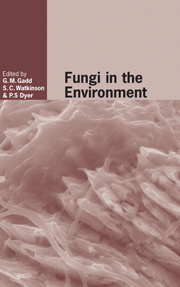Book contents
- Frontmatter
- Contents
- List of contributors
- Preface
- I Imaging and modelling of fungi in the environment
- II Functional ecology of saprotrophic fungi
- III Mutualistic interactions in the environment
- 8 Mycorrhizas and the terrestrial carbon cycle: roles in global carbon sequestration and plant community composition
- 9 Water relations in lichens
- 10 Development of the arbuscular mycorrhizal symbiosis: insights from genomics
- IV Pathogenic interactions in the environment
- V Environmental population genetics of fungi
- VI Molecular ecology of fungi in the environment
- Index
- References
9 - Water relations in lichens
from III - Mutualistic interactions in the environment
Published online by Cambridge University Press: 03 November 2009
- Frontmatter
- Contents
- List of contributors
- Preface
- I Imaging and modelling of fungi in the environment
- II Functional ecology of saprotrophic fungi
- III Mutualistic interactions in the environment
- 8 Mycorrhizas and the terrestrial carbon cycle: roles in global carbon sequestration and plant community composition
- 9 Water relations in lichens
- 10 Development of the arbuscular mycorrhizal symbiosis: insights from genomics
- IV Pathogenic interactions in the environment
- V Environmental population genetics of fungi
- VI Molecular ecology of fungi in the environment
- Index
- References
Summary
Lichen symbiosis
Lichen-forming fungi are a polyphyletic group of nutritional specialists, which derive fixed carbon from a population of living cyanobacteria and/or green algal cells. Every fifth fungus (approximately 14,000 species), or every second ascomycete, respectively, is a lichen. Species names of lichens refer to the fungal partner, the photoautotrophic symbionts having their own names and phylogenies. Most lichen-forming fungi are physiologically facultatively biotrophic, but occur in nature almost exclusively in the symbiotic state.
The majority of lichen-forming fungi form crustose, often quite inconspicuous thalli on or within the substratum where they meet their photoautotrophic partners, but about 25% of lichen mycobionts differentiate morphologically and anatomically complex 3-D thalli, either shrubby, leaf- or band-shaped, erect or pendulous, which are the result of an amazing hyphal polymorphism. Morphologically and anatomically complex lichen thalli are sophisticated culturing chambers, built up by the fungal partner, for a population of minute photobiont cells. Most lichen-forming fungi grow at or even above the surface of the substratum in order to keep their photoautotrophic partner adequately illuminated. Thus they are exposed to solar radiation, drought and temperature extremes. Lichen-forming ascomycetes produce a wide range of poly-phenolic secondary metabolites, which crystallize at hyphal surfaces in the medullary layer and/or within the peripheral cortex, giving the thalli a characteristic coloration (Huneck & Yoshimura, 1996). Most of the cortical secondary compounds absorb ultraviolet (UV) light and transmit longer wavelengths, thus protecting fungal and photobiont cells from radiation damage.
- Type
- Chapter
- Information
- Fungi in the Environment , pp. 185 - 200Publisher: Cambridge University PressPrint publication year: 2007
References
- 14
- Cited by



